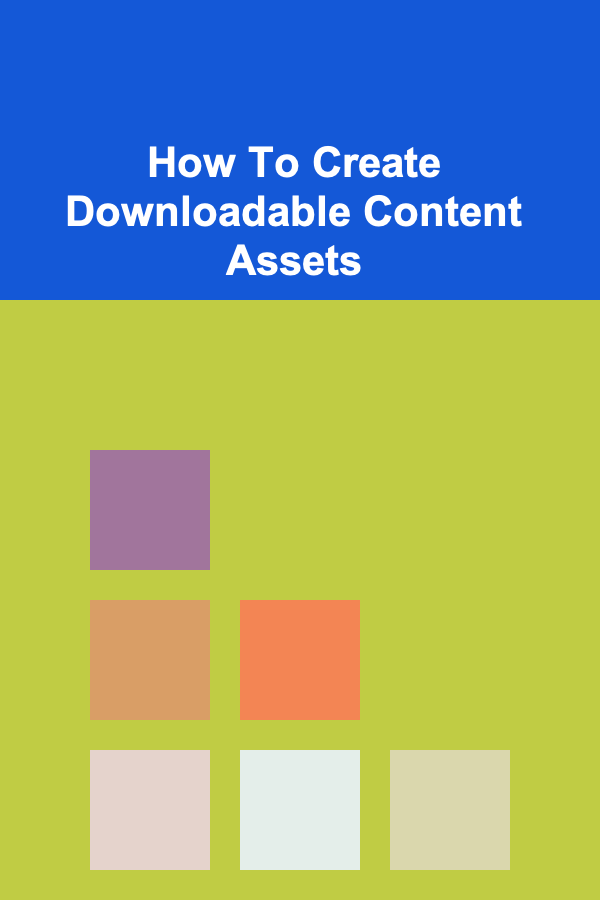
How To Create Downloadable Content Assets
ebook include PDF & Audio bundle (Micro Guide)
$12.99$11.99
Limited Time Offer! Order within the next:

Introduction: The Power of Downloadable Content
In the ever-evolving landscape of digital marketing, attracting and engaging your target audience is paramount. One of the most effective strategies to achieve this is through the creation and distribution of valuable, downloadable content assets. These assets, often referred to as "lead magnets," serve as incentives for users to provide their contact information, building your email list and nurturing them through the sales funnel. A well-crafted downloadable can establish your brand as a thought leader, provide immense value to your audience, and ultimately drive conversions. However, creating effective downloadable content goes beyond simply throwing information together. It requires strategic planning, a deep understanding of your audience's needs, and a commitment to delivering high-quality, actionable content.
This comprehensive guide will walk you through the entire process of creating compelling downloadable content assets, from identifying your target audience and their pain points to promoting your assets and analyzing their performance. We will explore various types of downloadable content, provide practical tips for crafting engaging content, and discuss strategies for maximizing the impact of your efforts.
Step 1: Understanding Your Audience and Their Needs
Before you even begin brainstorming content ideas, it's crucial to have a crystal-clear understanding of your target audience. Who are they? What are their demographics, psychographics, and online behaviors? What are their biggest challenges and pain points? What kind of information are they actively seeking?
Here's how to delve deeper into understanding your audience:
- Analyze Your Existing Customer Data: Examine your customer relationship management (CRM) system, website analytics, and social media insights. Identify patterns and trends in customer behavior, demographics, and interests. What products or services are they purchasing? What content are they engaging with on your website and social media channels? This data can provide valuable clues about their needs and preferences.
- Conduct Audience Research: Use surveys, polls, and interviews to directly solicit feedback from your target audience. Ask them about their challenges, goals, and the types of information they find most valuable. Tools like SurveyMonkey, Google Forms, and Typeform can be used to easily create and distribute surveys.
- Create Buyer Personas: Develop detailed representations of your ideal customers. Give them names, backgrounds, motivations, and pain points. This helps to humanize your target audience and allows you to tailor your content specifically to their needs. A good buyer persona should include details like age, job title, industry, goals, challenges, and preferred communication channels.
- Keyword Research: Identify the keywords and phrases that your target audience is using to search for information online. Tools like Google Keyword Planner, Ahrefs, and SEMrush can help you uncover relevant keywords and understand search volume. Use these keywords throughout your downloadable content to improve its search engine optimization (SEO) and make it easier for your target audience to find it.
- Competitor Analysis: Analyze the content that your competitors are creating and distributing. What types of downloadable assets are they offering? What topics are they covering? How are they promoting their content? This can help you identify gaps in the market and opportunities to create unique and valuable content.
By investing time and effort in understanding your audience, you can ensure that your downloadable content is highly relevant, engaging, and effective in attracting and converting leads.
Step 2: Choosing the Right Type of Downloadable Content
The type of downloadable content you create should align with your audience's needs, your business goals, and your available resources. Here are some popular and effective types of downloadable assets:
Ebooks
Ebooks are comprehensive guides that delve deep into a specific topic. They are perfect for providing in-depth information, establishing thought leadership, and generating high-quality leads. Ebooks require a significant investment of time and effort to create, but they can provide a substantial return on investment.
Examples:
- "The Ultimate Guide to Content Marketing"
- "How to Build a Successful Email Marketing Campaign"
- "A Beginner's Guide to Investing"
Checklists
Checklists are simple, actionable guides that help users accomplish specific tasks or goals. They are quick and easy to create and consume, making them an excellent option for generating a large number of leads. Checklists are particularly effective when they address a common pain point or provide a step-by-step solution.
Examples:
- "SEO Audit Checklist"
- "Website Optimization Checklist"
- "Social Media Marketing Checklist"
Templates
Templates provide users with ready-made frameworks or outlines that they can customize to their own needs. They can save users time and effort and help them achieve desired results more quickly. Templates are particularly effective for tasks that involve repetitive processes or require specific formats.
Examples:
- "Social Media Calendar Template"
- "Project Management Template"
- "Email Marketing Template"
Case Studies
Case studies showcase real-world examples of how your products or services have helped customers achieve success. They provide social proof and build trust, making them a powerful tool for generating leads and driving conversions. Case studies should be well-documented and include quantifiable results.
Examples:
- "How Company X Increased Sales by 50% Using Our Software"
- "How Our Consulting Services Helped Company Y Reduce Costs by 30%"
- "How Our Platform Enabled Company Z to Improve Customer Satisfaction"
White Papers
White papers are in-depth reports that provide authoritative information on a specific topic. They are often used in B2B marketing to educate potential customers about complex issues and position your company as a thought leader. White papers require extensive research and analysis.
Examples:
- "The Future of Artificial Intelligence in Healthcare"
- "The Impact of Cloud Computing on Small Businesses"
- "The Role of Data Analytics in Personalized Marketing"
Cheat Sheets
Cheat sheets are concise summaries of key information that users can quickly reference. They are useful for providing quick access to important facts, formulas, or best practices. Cheat sheets are often used as supplementary resources to other types of content.
Examples:
- "SEO Cheat Sheet"
- "Excel Keyboard Shortcuts Cheat Sheet"
- "HTML Cheat Sheet"
Webinars and Video Recordings
Webinars and video recordings offer interactive and engaging content that can attract a large audience. They provide an opportunity to showcase your expertise, answer questions in real-time, and build relationships with potential customers. Recording webinars and making them available as downloadable assets can significantly extend their reach.
Examples:
- "A Live Webinar on the Latest Trends in Digital Marketing"
- "A Recorded Video Tutorial on How to Use Our Software"
- "A Panel Discussion on the Future of Work"
Free Trials and Software Demos
Offering free trials or software demos is a highly effective way to generate qualified leads, especially for SaaS companies. It allows potential customers to experience the value of your product or service firsthand and can significantly increase the likelihood of conversion. Make sure the trial is long enough to allow the user to truly experience the benefits, and provide ample support and onboarding resources.
Examples:
- "A 14-Day Free Trial of Our Project Management Software"
- "A Live Demo of Our CRM Platform"
- "A Limited-Time Free Version of Our Photo Editing Software"
Consider your resources and the desired outcome when choosing the type of downloadable content to create. A well-chosen asset will resonate with your target audience and drive the desired results.
Step 3: Crafting Compelling and Valuable Content
Once you've chosen the type of downloadable content you want to create, it's time to focus on crafting compelling and valuable content that will resonate with your audience. Here are some key principles to keep in mind:
- Solve a Specific Problem: Your downloadable content should address a specific pain point or challenge that your target audience is facing. Provide actionable solutions and practical tips that they can implement immediately. The more specific and relevant your content is, the more valuable it will be.
- Provide Actionable Advice: Don't just present theoretical concepts; provide concrete steps that your audience can take to achieve their goals. Use examples, case studies, and real-world scenarios to illustrate your points and make your advice more relatable.
- Be Concise and Easy to Understand: Avoid using jargon or technical terms that your audience may not be familiar with. Write in a clear and concise style, and break up long blocks of text with headings, subheadings, bullet points, and images. The easier your content is to read and understand, the more likely people are to consume it.
- Use Visuals: Incorporate images, charts, graphs, and videos to make your content more visually appealing and engaging. Visuals can help to break up text, illustrate complex concepts, and capture the reader's attention. Tools like Canva and Piktochart can help you create professional-looking visuals.
- Proofread and Edit Carefully: Errors in grammar, spelling, and punctuation can damage your credibility and make your content appear unprofessional. Before publishing your downloadable asset, carefully proofread and edit it to ensure that it is free of errors. Consider asking a colleague or professional editor to review your content as well.
- Optimize for Readability: Use appropriate font sizes, line spacing, and margins to make your content easy to read. Consider using a sans-serif font for body text and a serif font for headings. Test your content on different devices and screen sizes to ensure that it looks good on all platforms.
- Add a Call to Action: Include a clear and compelling call to action (CTA) at the end of your downloadable content. Tell your audience what you want them to do next, whether it's to schedule a demo, request a consultation, or purchase your product or service. Make your CTA prominent and easy to click.
Remember, the goal is to provide genuine value to your audience. If your downloadable content is informative, helpful, and actionable, people will be more likely to share it, recommend it, and ultimately become customers.
Step 4: Designing an Attractive and Professional-Looking Asset
The visual appeal of your downloadable content is just as important as the content itself. A well-designed asset will grab attention, create a positive impression, and make your content more enjoyable to consume.
- Use a Consistent Brand Identity: Incorporate your brand colors, fonts, and logo into your design. This will help to reinforce your brand identity and make your downloadable asset instantly recognizable.
- Choose High-Quality Images and Graphics: Use professional-looking images and graphics that are relevant to your content. Avoid using low-resolution images or clip art that can make your asset look unprofessional. Sites like Unsplash, Pexels, and Pixabay offer a wide selection of free, high-quality images.
- Create a Visually Appealing Layout: Use a clean and uncluttered layout that is easy to navigate. Use headings, subheadings, and bullet points to break up text and make your content more scannable. Use white space effectively to create a sense of balance and readability.
- Use a Professional Design Tool: Consider using a professional design tool like Adobe InDesign or Canva to create your downloadable asset. These tools offer a wide range of features and templates that can help you create visually stunning designs. Even Canva offers templates that are great to start from for many assets.
- Optimize for Different Devices: Make sure that your downloadable asset is optimized for viewing on different devices, including desktops, laptops, tablets, and smartphones. Use a responsive design that adapts to different screen sizes.
- Consider Accessibility: Ensure that your downloadable asset is accessible to people with disabilities. Use alt text for images, provide captions for videos, and use sufficient color contrast. Following accessibility guidelines will make your content more inclusive and reach a wider audience.
Investing in professional design can significantly enhance the perceived value of your downloadable content and make it more effective in attracting and converting leads.
Step 5: Creating a Compelling Landing Page
Your landing page is the first point of contact for potential leads who are interested in downloading your content. It's crucial to create a compelling landing page that captures their attention, highlights the value of your asset, and encourages them to provide their contact information.
- Write a Clear and Concise Headline: Your headline should clearly communicate the value of your downloadable content and entice visitors to learn more. Use strong keywords and focus on the benefits that your audience will receive.
- Highlight the Key Benefits: Use bullet points or short paragraphs to highlight the key benefits of downloading your asset. Focus on the problems that it solves, the insights that it provides, and the results that it can help your audience achieve.
- Include a Visual Representation: Show a mockup or screenshot of your downloadable content to give visitors a better idea of what they will receive. This can help to increase their perceived value of the asset.
- Keep the Form Short and Simple: Only ask for the essential information that you need to qualify leads and personalize your follow-up communications. The longer your form is, the lower your conversion rate will be. Consider asking for just their name and email address initially.
- Use a Strong Call to Action: Use a clear and compelling call to action button that encourages visitors to download your asset. Use action-oriented language like "Download Now," "Get Your Free Copy," or "Access the Guide." Make the button visually prominent and easy to click.
- Provide Social Proof: Include testimonials, reviews, or case studies to build trust and credibility. Show visitors that other people have found your content valuable.
- Optimize for Mobile: Make sure that your landing page is optimized for mobile devices. A large percentage of your traffic will likely come from mobile users, so it's crucial to provide a seamless and user-friendly experience on all devices.
- Test and Optimize: Continuously test and optimize your landing page to improve its conversion rate. Experiment with different headlines, copy, images, and form fields to see what works best for your audience. A/B testing tools like Google Optimize can help you track your results and identify areas for improvement.
A well-optimized landing page can significantly increase the number of leads you generate from your downloadable content.
Step 6: Promoting Your Downloadable Content
Creating a great downloadable asset is only half the battle. You also need to promote it effectively to reach your target audience and generate leads.
- Email Marketing: Send an email to your existing subscribers to announce your new downloadable content. Highlight the key benefits and include a link to your landing page. Segment your email list to target subscribers who are most likely to be interested in your asset.
- Social Media Marketing: Share your downloadable content on your social media channels. Use engaging visuals and compelling copy to capture attention and encourage followers to download it. Consider using paid social media advertising to reach a wider audience.
- Blog Posts: Write a blog post that introduces your downloadable content and highlights its key benefits. Include a link to your landing page within the blog post. Optimize your blog post for search engines to attract organic traffic.
- Guest Blogging: Write a guest blog post for a relevant industry website or publication. Include a link to your downloadable content in your author bio or within the body of the article.
- Content Syndication: Repurpose your downloadable content into different formats, such as articles, infographics, or videos. Syndicate your content to other websites and platforms to reach a wider audience.
- Paid Advertising: Use paid advertising platforms like Google Ads and social media ads to target potential leads who are interested in your topic. Use keyword targeting and demographic targeting to reach the right audience.
- Partnerships: Partner with other businesses or organizations in your industry to promote your downloadable content. You can cross-promote each other's content to reach a wider audience.
- Thank You Page Promotion: After someone downloads your asset, take advantage of the "Thank You" page. Here you can offer related services or products, promote upcoming events, or provide links to other valuable resources.
By using a multi-faceted approach to promotion, you can maximize the reach of your downloadable content and generate a steady stream of leads.
Step 7: Analyzing and Optimizing Performance
Once you've launched your downloadable content campaign, it's important to track its performance and identify areas for improvement. Here are some key metrics to monitor:
- Landing Page Conversion Rate: Track the percentage of visitors to your landing page who convert into leads by downloading your asset. This metric will tell you how effective your landing page is at capturing leads.
- Download Rate: Track the number of times your downloadable content is downloaded. This metric will tell you how popular your asset is.
- Lead Quality: Evaluate the quality of the leads that you generate from your downloadable content. Are they qualified prospects who are likely to convert into customers? Track metrics like lead source, industry, job title, and company size.
- Engagement Rate: Track the engagement rate of your leads after they download your asset. Are they opening your emails? Are they visiting your website? Are they interacting with your content?
- Conversion Rate: Track the percentage of leads who convert into customers. This metric will tell you how effective your downloadable content is at driving sales.
- Traffic Sources: Discover which channels and sources are driving the most traffic to your landing page. This will inform where to focus future promotional efforts. Google Analytics is invaluable for this purpose.
Use data to guide your optimization efforts. For example, if your landing page conversion rate is low, experiment with different headlines, copy, and images. If your lead quality is poor, refine your targeting criteria. By continuously analyzing and optimizing your performance, you can maximize the ROI of your downloadable content campaigns. Use A/B testing to test variations of landing pages, email subject lines, and calls to action. Tools like Google Optimize and Optimizely can help automate the testing process.
Legal Considerations for Downloadable Content
Before distributing downloadable content, it's crucial to consider the legal aspects to protect both your business and your audience.
- Copyright: Ensure you have the rights to use all content included in your downloadable asset, including text, images, videos, and audio. Using copyrighted material without permission can lead to legal action. Properly attribute sources and obtain necessary licenses if required. Consider using royalty-free resources or creating original content.
- Privacy Policies: Be transparent about how you collect, use, and protect the personal information of users who download your content. Comply with relevant data privacy regulations, such as GDPR (General Data Protection Regulation) and CCPA (California Consumer Privacy Act). Include a clear and concise privacy policy on your landing page.
- Terms of Use: Clearly state the terms and conditions for downloading and using your content. This may include restrictions on redistribution, modification, or commercial use. Include a terms of use agreement that users must agree to before downloading the asset.
- Disclaimers: Include disclaimers where appropriate to limit your liability for any damages or losses that may result from the use of your content. For example, if you are providing financial or legal advice, include a disclaimer stating that you are not a licensed professional and that your advice is not a substitute for professional advice.
- Accessibility Compliance: As mentioned earlier, create content that is accessible to users with disabilities. Compliance with accessibility standards like WCAG (Web Content Accessibility Guidelines) can also have legal implications in some jurisdictions.
- Data Security: Implement security measures to protect the data of users who download your content. This includes using secure servers, encrypting data, and implementing access controls. Regularly review and update your security measures to protect against evolving threats.
Consulting with a legal professional can help you ensure that your downloadable content complies with all applicable laws and regulations.
Advanced Strategies for Downloadable Content
Once you've mastered the fundamentals of creating and promoting downloadable content, you can explore advanced strategies to take your campaigns to the next level.
- Personalization: Tailor your downloadable content to specific segments of your audience based on their demographics, interests, or behavior. Use dynamic content to personalize the experience and make it more relevant.
- Interactive Content: Create interactive downloadable assets, such as quizzes, calculators, or assessments. These types of content are more engaging and can generate more leads. Tools like Outgrow and Interact can help you create interactive content.
- Content Upgrades: Offer additional resources or bonuses to users who download your content. This can help to increase engagement and drive conversions. For example, you could offer a free checklist or template to users who download your ebook.
- Retargeting: Retarget users who have downloaded your content with targeted ads. This can help to keep your brand top-of-mind and encourage them to take the next step in the sales funnel.
- Account-Based Marketing (ABM): Use downloadable content as part of your ABM strategy to target specific companies or accounts. Create content that is tailored to their specific needs and challenges.
- Integrate with Marketing Automation: Integrate your downloadable content with your marketing automation system to automate lead nurturing and follow-up. Use workflows to send personalized emails, trigger actions based on user behavior, and track results.
- Gamification: Integrate game mechanics into your downloadable content to increase engagement and motivation. Award points, badges, or rewards for completing tasks or achieving goals.
By implementing these advanced strategies, you can maximize the impact of your downloadable content campaigns and achieve your business goals.
Conclusion: Embrace the Power of Downloadable Content
Downloadable content assets are a powerful tool for attracting leads, building your email list, and establishing your brand as a thought leader. By following the steps outlined in this guide, you can create compelling and valuable content that resonates with your audience and drives results. Remember to focus on understanding your audience, choosing the right type of content, crafting engaging content, designing an attractive asset, promoting your content effectively, and analyzing your performance. With careful planning and execution, you can harness the power of downloadable content to achieve your marketing goals and grow your business.

How To Grasp the Concept of Free Will vs. Determinism
Read More
How to Make Money Online as a Meteorologist: 10 Actionable Ideas
Read More
How to Organize Your Garage for a More Functional Workspace
Read More
How to Overcome the Fear of Being Alone
Read More
How to Master 3D Printing for Jewelry Making
Read More
Grasping Home Energy Management Systems for EVs: A Comprehensive Guide
Read MoreOther Products

How To Grasp the Concept of Free Will vs. Determinism
Read More
How to Make Money Online as a Meteorologist: 10 Actionable Ideas
Read More
How to Organize Your Garage for a More Functional Workspace
Read More
How to Overcome the Fear of Being Alone
Read More
How to Master 3D Printing for Jewelry Making
Read More